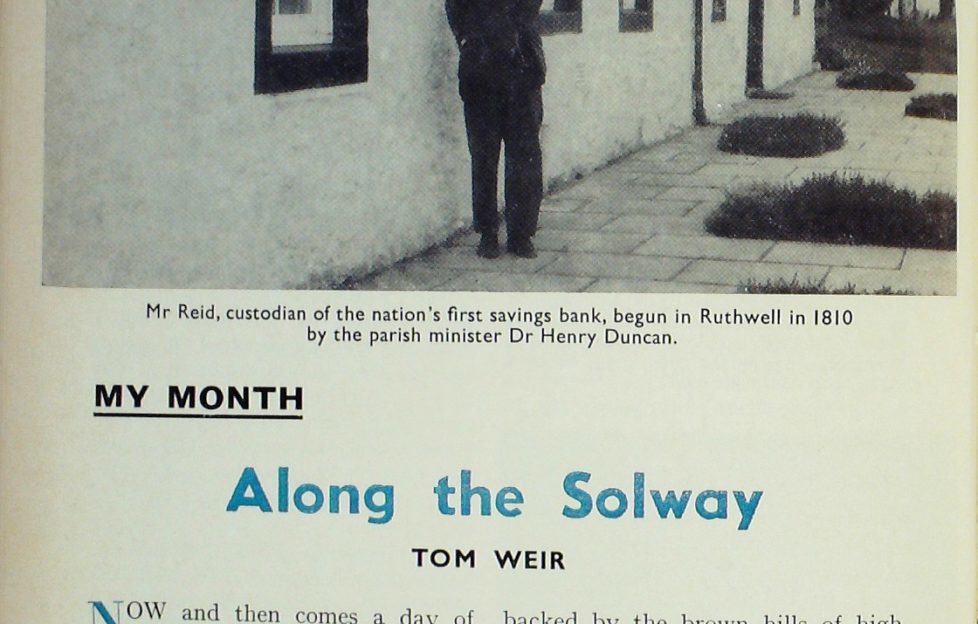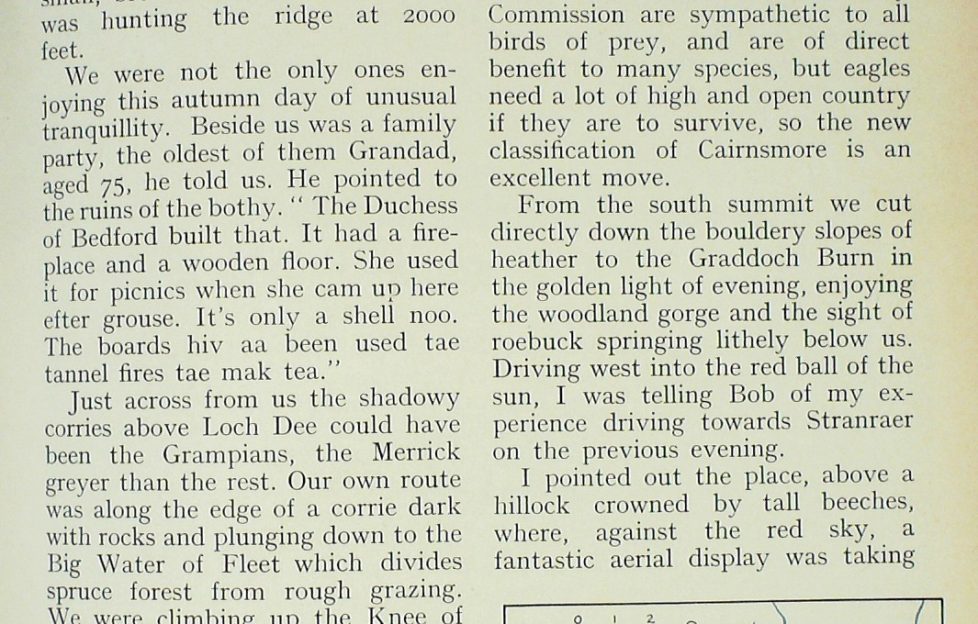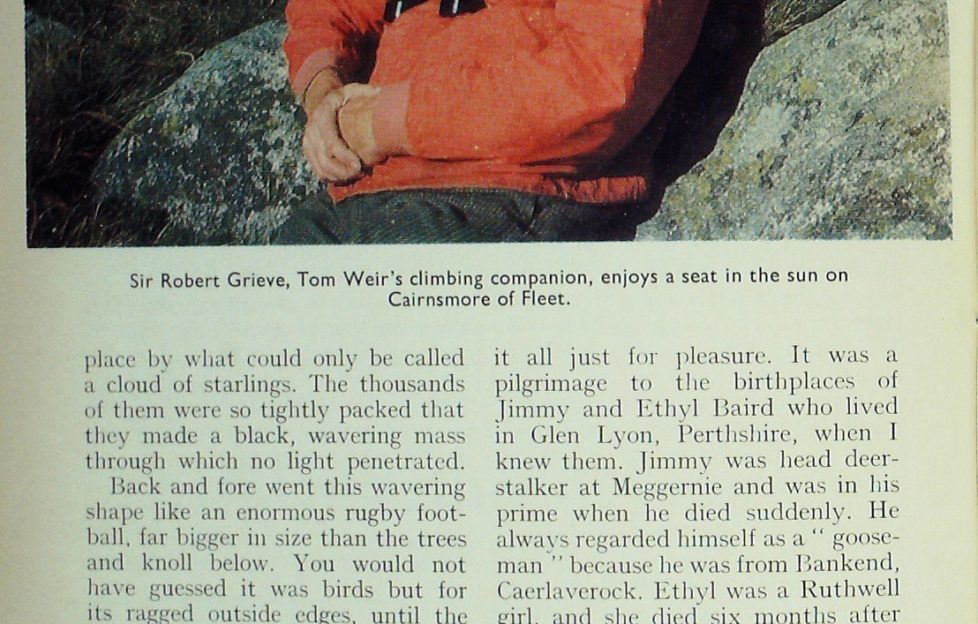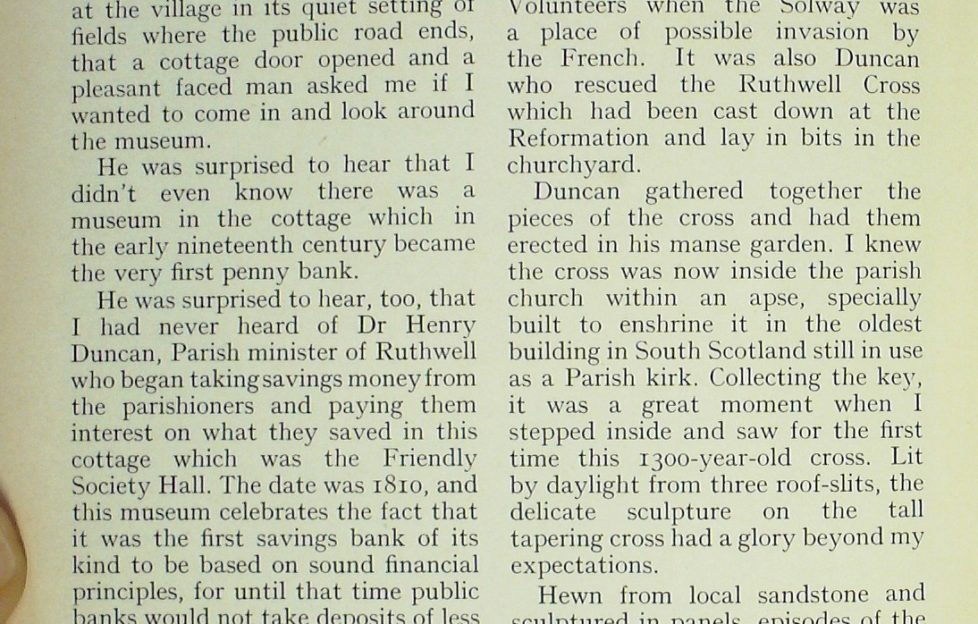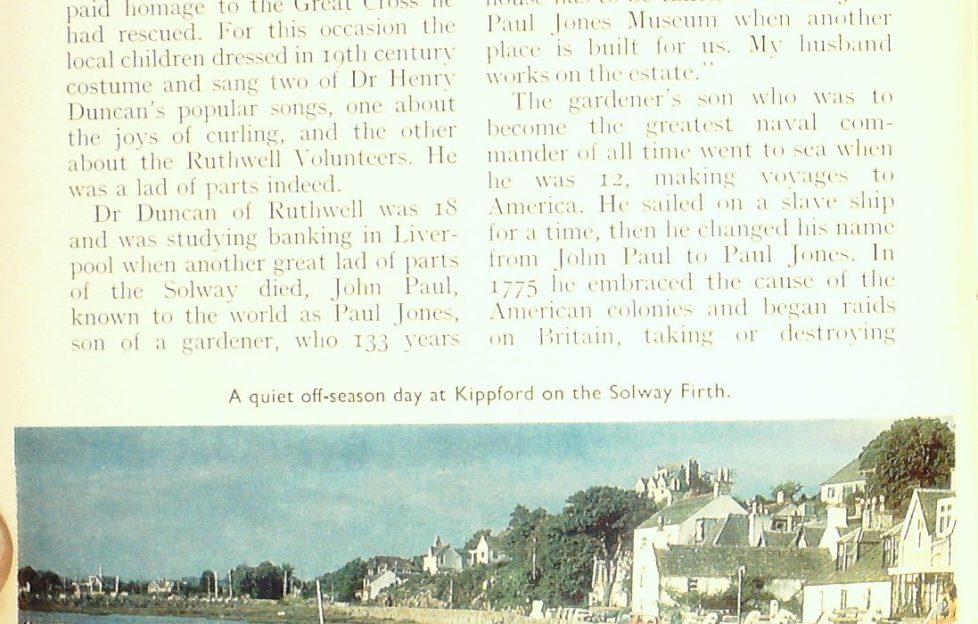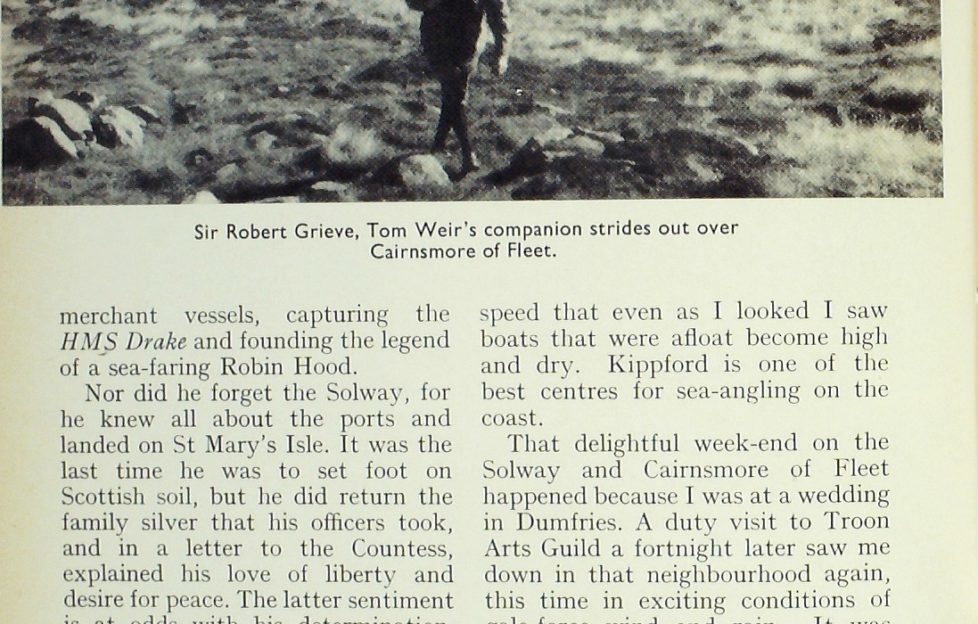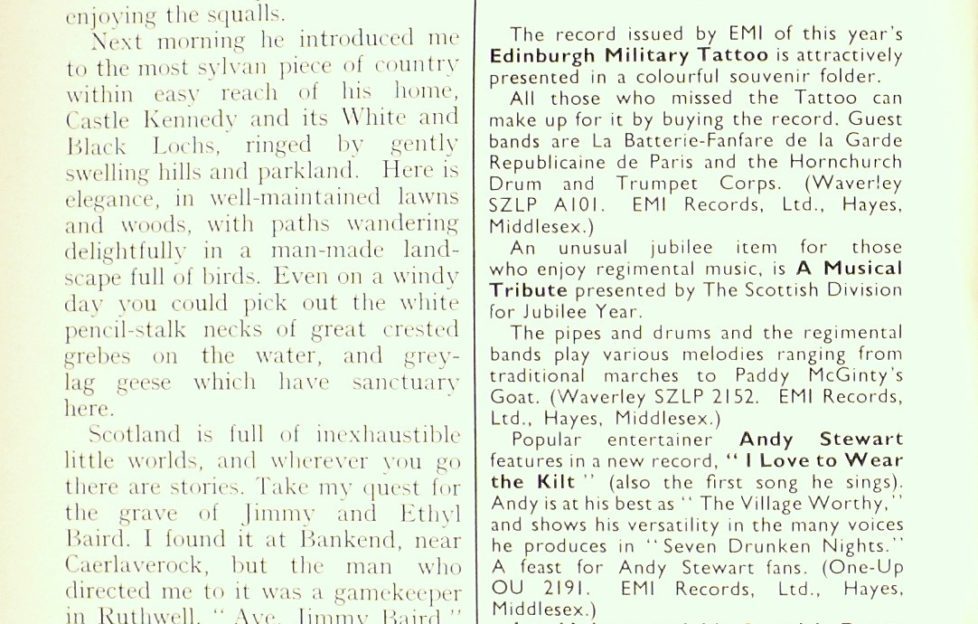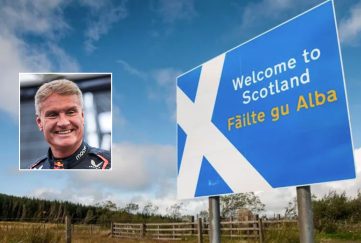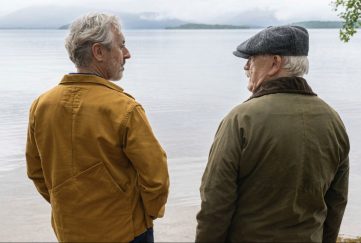Tom Weir | Along The Solway
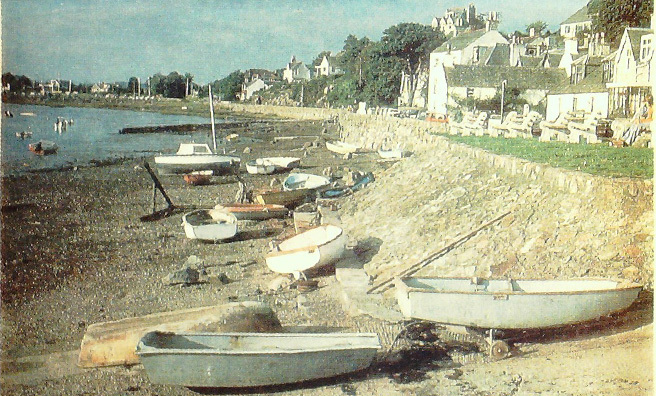
NOW and then comes a day of sheer perfection, when the sun shines from sunrise to sunset, and this was it.
I was on the Solway on the estuary of the River Cree with my old climbing pal Bob Grieve, and above us was Cairnsmore of Fleet, which I had never been up. Driving from Cairnryan that morning on the empty roads by Glen Luce and cheerful Newton Stewart had been a pleasure.
Cottages shone white in the sun and were reflected in the blue river —the Venice of Scotland, indeed— backed by the brown hills of high Galloway.
“You’re going to enjoy this path,” said Bob as we swung away just beyond Palnure on an estate track winding up through a wood to end where the runnel of the path began.
He was right. The path was a grassy trod, springy to the feet, leading through a copse to climb gently over Bardrochwood Moor and following the south-west shoulder of the hill. In shirt sleeves, the climbing seemed effortless, and the reward enormous, looking over the big bight of Wigtown Bay to the grey blue hills of the Isle of Man like a dreaming fragment of the Hebrides.
A Wildlife Haven
Cairnsmore is a granite hill, speckled on the top, with glittering boulders, and amongst them were hundreds of meadow pipits, rising in excited little flocks to settle again immediately and run about our feet. Eating our pieces at the cairn, we could hardly believe our eyes at the sight of fat bumble bees and small, brown butterflies. A kestrel was hunting the ridge at 2000 feet.
We were not the only ones enjoying this autumn day of unusual tranquillity. Beside us was a family party, the oldest of them Grandad, aged 75, he told us. He pointed to the ruins of the bothy.
“The Duchess of Bedford built that. It had a fireplace and a wooden floor. She used it for picnics when she cam up here efter grouse. It’s only a shell noo. The boards hiv a been used tae tannel fires tae male tea.”
Just across from us the shadowy corries above Loch Dee could have been the Grampians, the Merrick greyer than the rest. Our own route was along the edge of a corrie dark with rocks and plunging down to the Big Water of Fleet which divides spruce forest from rough grazing. We were climbing up the Knee of Cairnsmore when suddenly a great bird swung into view, followed by another.
The Pride of Galloway
Against the blue, they were silhouettes, wings stretched straight out, only the long fingers at the ends upturned ; but we had only seconds to enjoy the sight before one folded its wings to its sides and let its 10-lb. weight carry it into head-first drop.
Watching it vanish, I lost the other, but they could only have been golden eagles, the pride of Galloway, whose offspring are thought to be the ones now nesting in the Lake District to the delight of fell-walkers there.
It is because of the golden eagles and the wealth of moorland birds on the southern flank of Cairnsmore that this exceptional piece of Galloway has been given the status of National Nature Reserve. It is easy to see the reason why this protection was necessary, since so much of what used to be moorland in Galloway is now blanketed in coniferous woodlands.
The Forestry Commission are sympathetic to all birds of prey, and are of direct benefit to many species, but eagles need a lot of high and open country if they are to survive, so the new classification of Cairnsmore is an excellent move.
From the south summit we cut directly down the bouldery slopes of heather to the Graddoch Burn in the golden light of evening, enjoying the woodland gorge and the sight of roebuck springing lithely below us. Driving west into the red ball of the sun, I was telling Bob of my experience driving towards Stranraer on the previous evening.
Cavorting Starlings
I pointed out the place, above a hillock crowned bv tall beeches, where, against the red sky, a fantastic aerial display was taking place by what could only be called a cloud of starlings. The thousands of them were so tightly packed that they made a black, wavering mass through which no light penetrated.
Back and fore went this wavering shape like an enormous rugby football, far bigger in size than the trees and knoll below. You would not have guessed it was birds but for its ragged outside edges, until the football punctured and starlings began dropping out of it like air from a balloon as birds fell on trees and fields and covered telephone wires like strings of black heads.
Only once before have I seen such a spectacular gathering of cavorting starlings and that was in Norfolk over the reed beds of Hickling Broad.
On that day when I saw the starlings I had travelled the whole length of the Solway coast from Ruthwell in the east by Caerlaverock and Kirkbean to Kippford. Nor was it all just for pleasure. It was a pilgrimage to the birthplaces of Jimmy and Ethyl Baird who lived in Glen Lyon, Perthshire, when I knew them. Jimmy was head deerstalker at Meggernie and was in his prime when he died suddenly. He always regarded himself as a “goose-man” because he was from Bankend, Caerlaverock. Ethyl was a Ruthwell girl, and she died six months after Jimmy.
I had never been to either village, though I had talked about them with the deceased often enough. Jimmy was a haaf-netter as well as a good shot and he loved the Solway. Ethyl was proud of the fact that the Ruthwell Cross in the village kirk is regarded as perhaps the finest early Christian monuments in existence.
Ethyl left Glen Lyon to take up house at Ruthwell with her young son, but died before she had a chance to occupy the white-washed cottage in the village street which was to be hers. It was while looking at the village in its quiet setting of fields where the public road ends, that a cottage door opened and a pleasant faced man asked me if I wanted to come in and look around the museum.
A Little-known Pioneer
He was surprised to hear that I didn’t even know there was a museum in the cottage which in the early nineteenth century became the very first penny bank.
He was surprised to hear, too, that I had never heard of Dr Henry Duncan, Parish minister of Ruthwell who began taking savings money from the parishioners and paying them interest on what they saved in this cottage which was the Friendly Society Hall. The date was 1810, and this museum celebrates the fact that it was the first savings bank of its kind to be based on sound financial principles, for until that time public banks would not take deposits of less than £10.
Mr Reid, the custodian, showed me the wooden box, like a little cupboard with drawers inside for holding the money, and he showed me some of the coins of the period. The census of 1811 shows the parish had only 1184 people in it, but £151 was saved in that year, £176 in the next year, £241 in the third. By 1814 the bank had £1164, which reveals how the savings habit caught on in an agricultural community where the average wage was under 10s. a week.
Henry Duncan, a son of the manse was emerging for me as a very exceptional man, for he had studied banking in addition to attending three universities. He chose Ruthwell because the quiet life suited him, but with a sharp mind like his lie was almost fated to become the Moderator of the General Assembly in 1839.
A lover of literature, writer, poet, antiquarian, student of banking, lie was also Captain of the Ruthwell Volunteers when the Solway was a place of possible invasion by the French.
“…glory beyond my expectations.”
It was also Duncan who rescued the Ruthwell Cross which had been cast down at the Reformation and lay in bits in the churchyard.
Duncan gathered together the pieces of the cross and had them erected in his manse garden. I knew the cross was now inside the parish church within an apse, specially built to enshrine it in the oldest building in South Scotland still in use as a Parish kirk. Collecting the key, it was a great moment when I stepped inside and saw for the first time this 1300-year-old cross. Lit by daylight from three roof-slits, the delicate sculpture on the tall tapering cross had a glory beyond my expectations.
Hewn from local sandstone and sculptured in panels, episodes of the life and death of Christ are portrayed. Scholars cannot account for its extraordinary quality, with its runes and vine-leaf tracery created in an age of barbarism. Blessings on the Rev. Gavin Young who disobeyed the order to destroy it in 1642, but let it fall into a specially prepared trench so that it would not be forgotten.
As for Henry Duncan who collected the thrown-out pieces and stood the cross up in his manse, he abandoned the Church of Scotland at the Disruption, and at the age of seventy gave up his living, moved into a tiny two-roomed cottage and preached his sermons in the open air, an individualist to the last.
It was an event for Ruthwell when in 1974 there came to the village the great, great, great grandson of their most famous man to open the Duncan Savings Bank Museum as a tribute to the Father of Savings Banks. Afterwards the party made their way to the old kirk and paid homage to Great Cross he had rescued. For this occasion the local children dressed in 19th century costume and sang of Dr Henry Duncan’s popular songs, one about the joys of curling, and the other about the Ruthwell Volunteers. He was a lad of parts indeed.
Dr Duncan of Ruthwell was 18 and was studying banking in Liverpool when another great lad of parts of the Solway died, John Paul, known to the world as Paul Jones, son of a gardener, who 133 wars after his death, was elected to the USA’s Hall of fame. Motoring west along the sunny Solway coast that afternoon I sudden I remembered that Jones had been born at Kirkbean.
A villager told me to drive up to Arbigland and near the gate to the big house I would find the cottage where he was born.
“Come in,” said Mrs Dugan who occupies it. “This is the room where he was born, and we still use it as a bedroom. The house has to be taken over as a John Paul Jones Museum when another place is built for us. My husband works on the estate.
The gardener’s son who was to become the greatest naval commander of all time went to sea when he was 12, making voyages to America. He sailed on a slave ship for a time, and then he changed his name from John Paul to Paul Jones. In 1775 he embraced the cause of the American colonies and began raids on Britain, taking or destroying merchant vessels, capturing the HMS Drake and founding the legend of a sea-faring Robin Hood.
Nor did he forget the Solway, for he knew all about the ports and landed on St Mary’s Isle. It was the last time he was to set foot on Scottish soil, but he did return the family silver that his officers took, and in a letter to the Countess, explained his love of liberty and desire for peace. The latter sentiment is at odds with his determination, fearless courage and ferocity in battle.
Along the coast
From his family cottage at Kirkbean I followed the road round to Kippford where the tide was ebbing visibly on the narrow fjord of the Rough Firth. In the late sunshine of afternoon, the white houses of the village street and the gentle hills across the water had a tranquil quality peculiar to the Solway where fields and pastures of cattle go down to the sea. Tides here run with such speed that even as I looked I saw boats that were afloat become high and dry. Kippford is one of the best centres for sea-angling on the coast.
That delightful week-end on the Solway and Cairnsmore of Fleet happened because I was at a wedding in Dumfries. A duty visit to Troon Arts Guild a fortnight later saw me down in that neighbourhood again, this time in exciting conditions of gale-force wind and rain. It was the transition from wild storm to bursts of sunshine which made it thrilling.
The change came at Turnberry, as we hit the coast, and a rainbow formed over a sea churned white like buttermilk, above which rose the black hulk of Ailsa Craig, looking infinitely higher than its 1100 feet. After that it was magic all the way, waves bursting on the rocks like shivered crystal, glimpses of Arran peaks, Ballantrae village sparkling on its headland, bracken rust-red on the hills. Then the next squall would blatter the windscreen.
In Glenn App, though, it was suddenly winter, as the rain changed to ball-bearings of hail, a blizzard of them blotting out visibility and forcing me to switch on headlights and reduce to a crawl. When it passed, everything was white.
Soon I was pulling into Bob Grieves house at Cairnryan, where, from his window perch, he had been enjoying the squalls.
Next morning he introduced me to the most sylvan piece of country within easy reach of his home, Castle Kennedy and its White and Black Lochs, ringed by gently swelling hills and parkland. Mere is elegance, in well-maintained lawns and woods, with paths wandering delightfully in a man-made landscape full of birds. Even on a windy day you could pick out the white pencil-stalk necks of great crested grebes on the water, and greylag geese which have sanctuary here.
Scotland is full of inexhaustible little worlds, and wherever you go there are stories. Take my quest for the grave of Jimmy and Ethyl Baird. I found it at Bankend, near Caerlaverock, but the man who directed me to it was a gamekeeper in Ruthwell.
“Aye, Jimmy Baird,” he said. “He was a keen haaf-nerter, and he was very good. I used to buy salmon from him. His wife, Ethyl, used to live in that house over there before site got married. Her father was a farmworker.”
In a wee country like ours, few country folk are forgotten.
In the gallery on the right you can see Tom Weir’s column as it appeared in the December 1977 issue of The Scots Magazine. Check out the last page for our “Listen To This” feature, too, to see the kind of traditional music we were into back then! It’s a far cry from the Ultimate Scottish Playlist, but we still have a traditional section in the magazine on occasion.
More…
Read more from Tom!
We have an extensive archives of Tom Weir’s great columns for The Scots Magazine, and we’re slowly getting them published digitally for new generations to enjoy.
To see the columns we have online so far, click here for Tom’s online archives.


